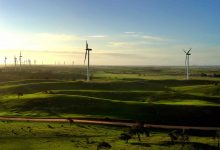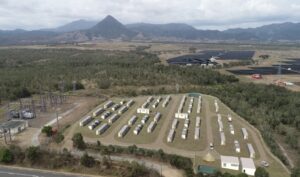The federal government owned utility Snowy Hydro says it will expand the scope of its wind and solar tender after confirming that “firm renewables” can deliver prices “significantly” below current “base-load”, or wholesale, prices.
Snowy Hydro went to the market earlier this year seeking contracts for 800MW of wind and solar capacity, and now says it will expand this to 900MW from nine different wind and solar projects.
CEO Paul Broad told a Senate Estimates Committee hearing on Monday that 17,000MW of wind and solar capacity had been offered into the tender, and nine new projects stretching from Queensland to Victoria had been chosen which would add some 2 terawatt hours of “base-load renewables firmed by existing Snowy Hydro assets.”
An announcement would be made within two weeks.
“We will do contracts with them to firm up energy at prices points significantly below the price points of what baseload power is,” Broad said. Later, in the hour-long testimony, Broad said: “We will firm up (wind and solar) at prices significantly below the current market for wholesale (electricity).”
Broad’s assessment will give Snowy Hydro’s federal government owners something to think about, particularly as many Coalition MPs and their media boosters repeat their call for “new baseload” coal generation, and energy minister Angus Taylor calls for more “fair dinkum power” in the system, and rails against the amount of wind and solar.
Snowy’s comments echo those of Origin Energy in recent weeks, which noted that the cost wind and solar were below the “marginal” cost of black coal generation.
That’s because of the soaring price of coal, which is making the operating cost of coal more expensive than the total cost of wind and solar generation. Add in the capital costs of coal, and new coal generation is even less able to compete.
Broad told the Senate Estimates back in May that Snowy was looking at prices of wind and solar in the range of, $40, $45 and $50s/MWh.
It would appear, given the results of the tender, that Snowy found those pricing points.
Add in its own estimates of the “levellised cost of storagte” at between $25-$30/MWh, and that gives a total well below the recent wholesale price of electricity in NSW and Victoria, which has been more than $90/MWh.
Broad indicated that the falling cost of renewables, and the “massive” amount of new wind and solar coming into the market were improving the economic case for the proposed Snowy 2.0 pumped hydro scheme.
“The market is unfolding at a pace that most people don’t seem to appreciate,” Broad said.
“There are massive amounts of renewables coming into the market”, meaning that excess capacity will have to be either curtailed or soaked up in storage. Black coal couldn’t compete on price, he said, and brown coal is too inflexible.
Broad said that Snowy had found the projected pumping costs were now lower than original business case, and suggested that the projected “internal rate of return” would be greater than 8 per cent.
“We think the economics are going in our favour,” Broad said.
Snowy has yet to release full studies, including environmental impacts, drilling surveys and financial analysis, but expects to make a final investment decision in December, once it also gets clarity on transmission spending and commitments.
Broad said Snowy would also be releasing studies showing the advantage of having the scheme go ahead – both to Snowy Hydro and to the general consumer – and would compare what would happen if it didn’t, or storage was focused on batteries.
Hopefully, that study won’t be as simplistic and misleading as the assessment of battery storage that it made last year while pushing the case for its scheme.
The storage industry will be watching with interest – previous Snowy estimates have suggested more coal and less battery storage in the system mix if Snowy 2.0 goes ahead, and some of its assumptions suggest it is a case of “us or them” when it came to batteries.
Despite his bleak assessments on the costs of coal, and the rapid change in the system, Broad said that coal would still be operating in the market beyond 2060. “We are very lucky in Australia to have such great coal plants,” he said. (He also suggested that there were more than 1,400 coal plants being built or planned around the world, which is actually not true).
Broad also defended the company’s bidding strategy, particularly in the recent events in South Australia where Snowy assets were at the forefront of some extraordinary pricing and bidding patterns that below wholesale prices out significantly. Broad described it as the market at work.
Snowy also defended its criticism of the proposed change in settlement periods from 30 minutes to 5 minutes, which have been designed to address the kind of bidding patterns witnessed in July, and which are expected to favour battery storage and other fast-starting technology.
Snowy insists it will reduce competition in the market. Broad has also criticised demand management schemes, describing them as “enforced blackouts.”








